Did you know that there are approximately 40 species of falcons in the world? These majestic birds of prey can be found on all continents, except Antarctica. Falcons are known for their incredible speed, agility, and hunting prowess. From the largest gyrfalcon to the smallest pygmy falcon, each species has its own unique characteristics and habitats. Join us as we explore the fascinating world of falcons and discover the different types of falcons that grace our skies.
What are Falcons?
Falcons belong to the genus Falco and are considered birds of prey. They have thin, tapered wings that allow them to fly at high speeds. Falcons exhibit sexual dimorphism, with females being larger than males.
Genus Falco: Birds of Prey with Tapered Wings
In the world of avian predators, falcons stand out for their remarkable features. As part of the genus Falco, these birds are known for their agile flight and hunting prowess. One of the distinguishing characteristics of falcons is their thin, tapered wings.
“Falcons have adapted to their predatory lifestyle with tapered wings that enable them to swiftly maneuver through the air, reaching impressive speeds and changing direction with remarkable agility.”
These streamlined wings not only allow falcons to achieve high speeds but also provide them with exceptional control during flight. The tapered shape reduces drag and increases the bird’s aerodynamic efficiency, making them well-suited for chasing down prey in mid-air.
Sexual Dimorphism: Females Larger than Males
Falcons also exhibit sexual dimorphism, meaning there are distinct differences in size and appearance between males and females. In most falcon species, the females are noticeably larger than their male counterparts.
“This difference in size is believed to be an adaptation related to the specific roles each gender plays in the reproductive process. The larger size of female falcons may provide them with advantages during incubation and brooding.”
While the reason for this size difference is not fully understood, it is thought to be linked to the reproductive strategies and behaviors exhibited by falcon pairs.
In Summary
Falcons, as part of the genus Falco, are birds of prey characterized by their thin, tapered wings and sexual dimorphism. These aerial hunters have evolved to excel in fast flight and adapt to their specific roles in reproduction. As we delve deeper into the world of falcons, we will discover the diverse range of species and their unique attributes.
Types of Falcons
Falcons are a diverse group of birds, with approximately 40 different species. Each species has its own unique characteristics and adaptations. Let’s take a closer look at two notable types of falcons: the gyrfalcon and the pygmy falcon.
Gyrfalcon
The gyrfalcon (Falco rusticolus) is the largest species of falcon, measuring up to 65 cm in length. It is found mainly in the Arctic and subarctic regions, including North America, Europe, and Asia. With its powerful build and impressive size, the gyrfalcon is a formidable predator.
The gyrfalcon is known for its striking plumage, which can range from dark gray to pure white. Its feathers help it blend into its snowy habitat during the winter months. This species primarily feeds on small mammals and birds, using its speed and agility to catch its prey mid-flight.
Pygmy Falcon
On the opposite end of the size spectrum, we have the pygmy falcon (Polihierax semitorquatus). This tiny falcon measures just 20 cm in length and is found in sub-Saharan Africa. Despite its small size, the pygmy falcon is a mighty hunter.
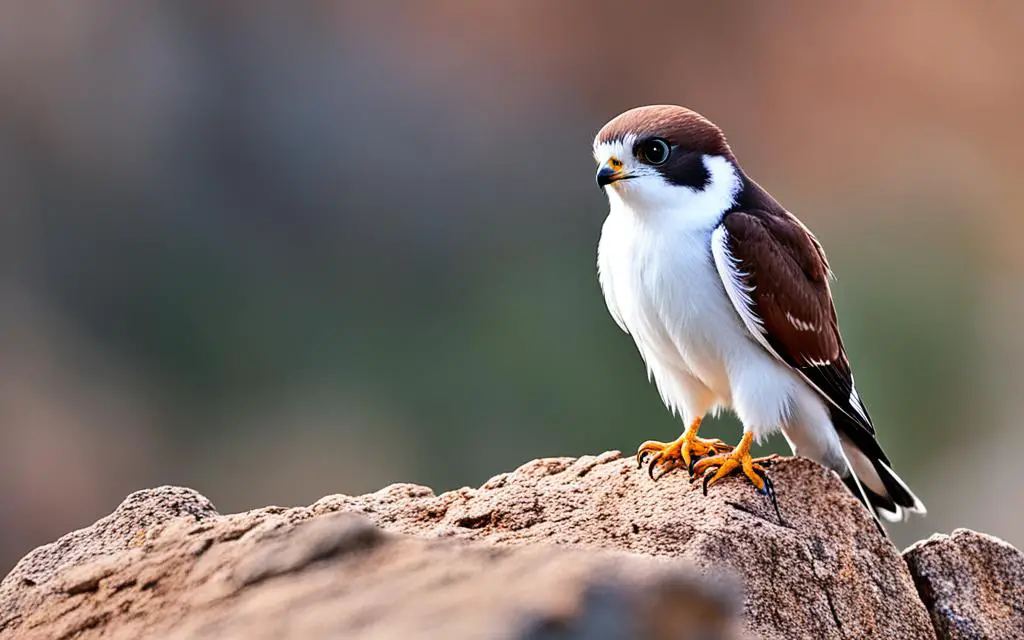
The pygmy falcon is known for its distinctive black and white plumage, which provides excellent camouflage in its natural habitat. It primarily feeds on insects and small reptiles, using its sharp beak and keen eyesight to spot and capture its prey.
These are just two examples of the incredible diversity within the falcon family. From the majestic gyrfalcon to the pint-sized pygmy falcon, each type of falcon offers its own unique beauty and hunting prowess.
Falcon Characteristics
Falcons are known for their remarkable speed and agility. These predatory birds possess slender bodies and sharp, curved beaks that distinguish them from other raptors. Unlike hawks, falcons rely on their beaks to swiftly and efficiently kill their prey, showcasing their predatory behavior.
The beak shape of falcons is specifically adapted for their hunting style. With a sharp, hooked tip, the beaks of falcons enable them to inflict precise and lethal puncture wounds on their prey. This specialized feature allows falcons to swiftly incapacitate their victims, making them formidable predators in the avian world.
Another characteristic that sets falcons apart is their slender bodies. This streamlined physique contributes to their exceptional speed and maneuverability during flight. Falcons have long, narrow wings that reduce drag, allowing them to reach incredible speeds as they pursue their prey. With their swift aerial movements, falcons are often able to outmaneuver and outpace their targets, making them highly successful hunters.
Exceptional Predators
“With their fast falcons, slender bodies, and sharp beaks, these birds exhibit impressive predatory behavior, adapting flawlessly to their environment.”
The combination of their fast flight, predatory behavior, beak shape, and slender bodies makes falcons some of the most efficient hunters in the animal kingdom. They are relentless in their pursuit of prey, using their speed and agility to launch surprise attacks from the sky. This predatory prowess positions falcons at the top of the avian food chain.
The unique characteristics of falcons make them a fascinating group of birds to observe and study. From their lightning-fast dives to their precision kills, fast falcons truly exemplify the power and grace of nature’s predators.
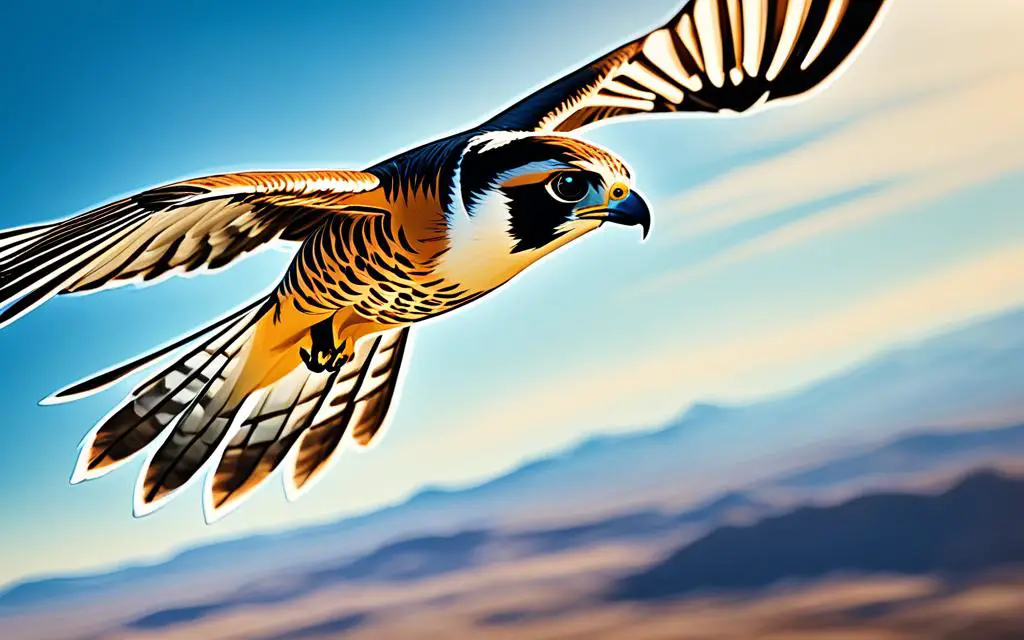
Peregrine Falcon – The Fastest Falcon
The peregrine falcon holds the title of the fastest falcon and is renowned as the fastest animal on Earth. With its remarkable speed and agility, this majestic bird can reach incredible speeds of up to 200 mph when diving to capture its prey.
One of the most fascinating aspects of the peregrine falcon is its hunting behavior. These skilled hunters are known for their exceptional aerial hunting prowess, especially when it comes to catching other birds in flight. Their remarkable speed allows them to surprise their prey with lightning-fast dives, making them virtually unstoppable in the air.
Witnessing a peregrine falcon in action is a truly breathtaking experience. As they soar through the sky with incredible grace, their streamlined bodies and sharp talons enable them to swiftly capture their target mid-flight. Whether it’s a flock of pigeons or a single songbird, the peregrine falcon’s hunting skills are unrivaled.
If you ever have the opportunity to observe a peregrine falcon in its natural habitat, you’ll be astounded by its sheer speed and precision. It’s truly a testament to the remarkable capabilities of these magnificent creatures.
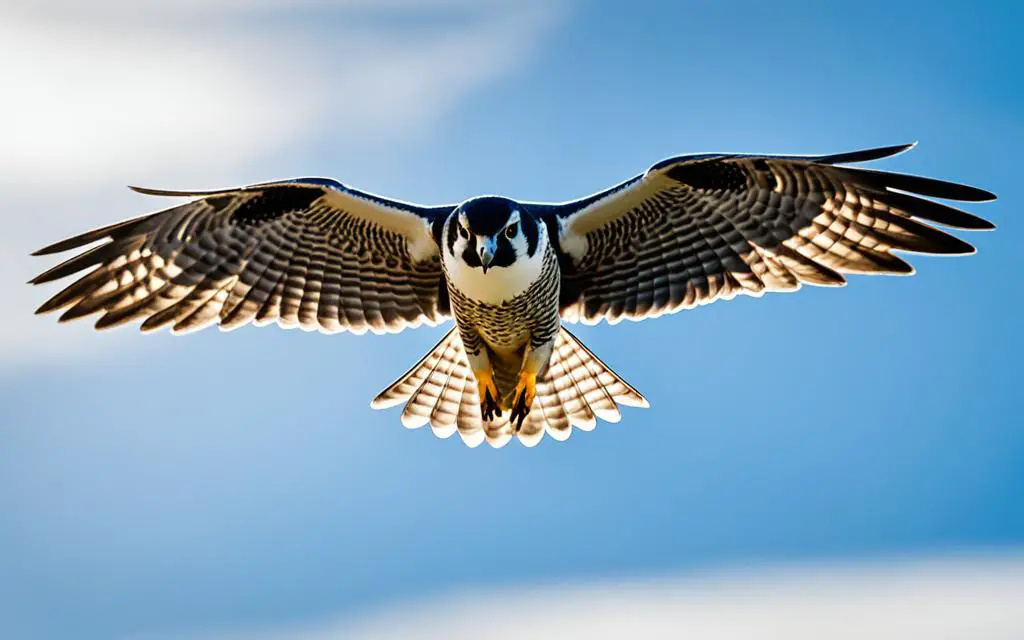
Stay tuned for the next section where we delve into the diverse habitats of falcons and uncover the remarkable places these birds call home.
Habitats of Falcons
Falcons are adaptable birds that can be found in a variety of habitats, each suited to their specific needs. From open country to cliffs and tundras, falcon habitats are diverse and unique. Understanding these habitats is crucial to appreciating the fascinating lives of these majestic birds of prey.
The Variety of Falcon Habitats
Falcons have successfully colonized different environments around the world. One common habitat for falcons is open country, which includes grasslands and agricultural areas. These habitats provide an abundance of prey, such as small mammals and birds, and offer plenty of space for falcons to hunt and soar through the skies.
Another significant falcon habitat is cliffs and rocky outcrops. These rugged landscapes offer nesting sites, shelter, and vantage points for falcons to spot and pursue their prey. The steep cliffs also provide protection from potential predators, ensuring the safety of the falcon’s nesting sites.
In colder regions, falcons can be found in tundras and Arctic regions. Here, they adapt to the harsh conditions and rely on their specialized hunting skills to target small mammals and birds that inhabit these frozen landscapes.
Migratory Behavior and Nesting Sites
Some falcons exhibit migratory behavior, traveling long distances in search of favorable conditions and ample food sources. These migratory falcons have different nesting sites along their migratory routes, which they return to every year to breed and raise their young.
On the other hand, some falcons are sedentary and stay in one territory year-round. They establish permanent nesting sites within their chosen habitat, and these sites become essential for their survival and reproductive success. Falcons may use old nests of other raptors or build their nests in trees or on rocky formations, depending on their habitat preferences.
Understanding falcon habitats, nesting sites, and migratory behavior is vital for conservation efforts and ensuring the long-term survival of these magnificent birds. By preserving and protecting their habitats, we can continue to witness the awe-inspiring displays of speed, agility, and hunting prowess exhibited by falcons.
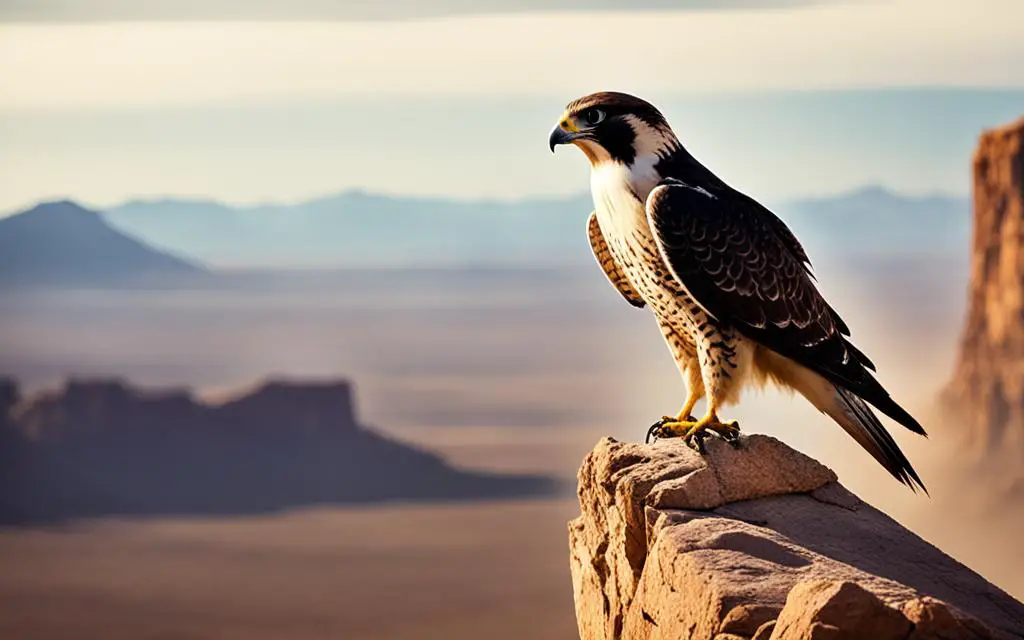
Peregrine Falcon History
In the mid-20th century, the peregrine falcon population experienced a dramatic decline that threatened their existence. The primary cause of this decline was the widespread use of a chemical called DDT. This harmful pesticide was used extensively in agriculture, but its unintended consequences had severe impacts on the peregrine falcon population.
DDT had a devastating effect on the peregrine falcon by causing nesting failures. When the falcons consumed prey contaminated with DDT, the chemical weakened their eggshells, leading to increased egg breakage and reduced reproductive success.
This decline in the peregrine falcon population was a matter of great concern for wildlife conservationists and bird enthusiasts. Acknowledging the urgency of the situation, conservation efforts were initiated to save these magnificent birds of prey from further decline.
One of the most significant milestones in the conservation of peregrine falcons was the banning of DDT in numerous countries. This crucial step led to a gradual recovery in the peregrine falcon population. With the removal of this chemical from their environment, peregrine falcons were able to regain their strength and successfully reproduce.
Conservation organizations worked tirelessly to protect and restore the habitats of peregrine falcons, ensuring the availability of suitable nesting sites and promoting awareness about their ecological importance. Through captive breeding programs and habitat conservation, their population gradually started to rebound.
Today, thanks to dedicated conservation efforts and the ban on DDT, the peregrine falcon population has shown a remarkable recovery. These majestic birds are no longer on the brink of extinction and can be seen soaring through the skies once again.
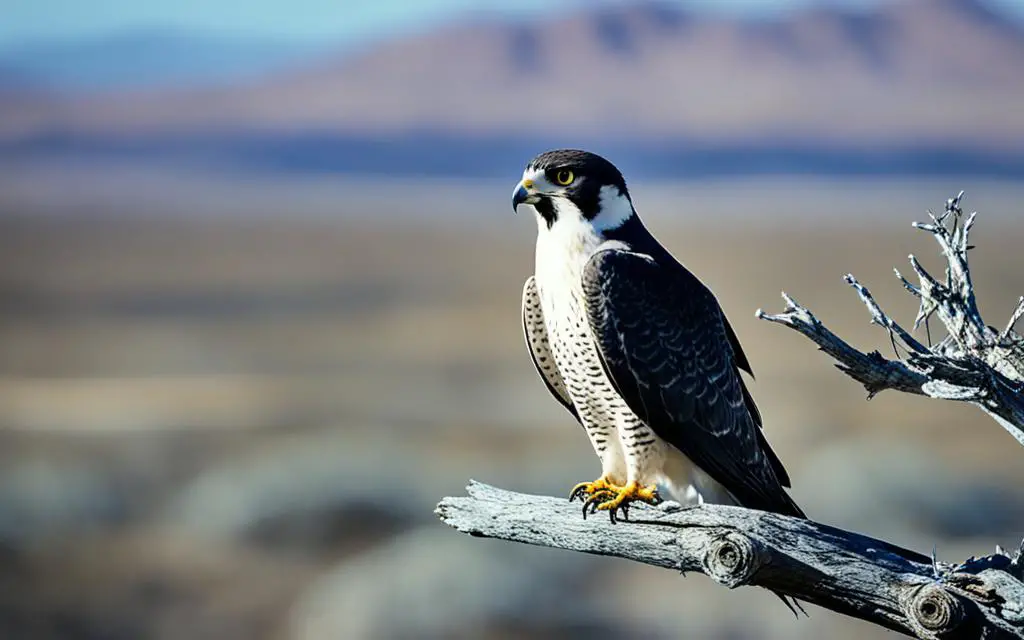
Conservation Efforts for Peregrine Falcons
Conservation initiatives for peregrine falcons focused on multiple fronts, including:
- Protection of nesting sites: Identifying and safeguarding critical breeding sites to provide undisturbed nesting areas for peregrine falcons.
- Captive breeding programs: Establishing programs to breed peregrine falcons in captivity and release them into the wild to supplement the wild population.
- Habitat restoration: Restoring and preserving suitable habitats for peregrine falcons, ensuring access to food sources and safe nesting sites.
- Monitoring and research: Conducting scientific studies to track the recovery of the peregrine falcon population and monitor their behavior and ecological interactions.
- Public awareness and education: Raising awareness about the importance of conservation and inspiring communities to take action to protect peregrine falcons and their habitats.
Through these combined efforts, we have witnessed the remarkable resilience of the peregrine falcon population. Their recovery serves as a powerful testament to the impact of conservation initiatives and the critical role we play in preserving the diversity of our natural world.
| Conservation Efforts | Results |
|---|---|
| Banning of DDT | Reduction in nesting failures and improved reproductive success |
| Protection of nesting sites | Providing undisturbed breeding areas for peregrine falcons |
| Captive breeding programs | Supplementing the wild population and increasing breeding success |
| Habitat restoration | Preserving and enhancing suitable habitats for peregrine falcons |
| Monitoring and research | Tracking population recovery and gaining insights into their ecology |
| Public awareness and education | Fostering understanding and support for peregrine falcon conservation |
Falcon Taxonomy
Falcons are fascinating birds that belong to the Falconidae family and are further classified into different groups. Let’s explore the taxonomy of these majestic creatures.
The Falconidae Family
The Falconidae family consists of various birds of prey, including Falcons, Hobbies, and Kestrels. These birds share similar characteristics but also have distinct features that set them apart.
Falcons
Within the Falconidae family, Falcons are a prominent group with approximately 39 species. They are known for their exceptional speed, agility, and hunting abilities. Falcons have long, tapered wings that enable them to reach incredible speeds in flight.
Hobbies
Hobbies are another group within the Falconidae family. They are small falcons with long, narrow wings, agile flight patterns, and remarkable hunting skills. Hobbies are often found in open habitats, where they pursue their prey with precision.
Kestrels
Kestrels are also part of the Falconidae family and are known for their hovering hunting technique. They have exceptional eyesight, which allows them to spot their prey from great distances. Kestrels can often be seen perched on high vantage points, scanning the area for potential meals.

Understanding the taxonomy of Falcons, Hobbies, and Kestrels provides valuable insights into the unique characteristics and behaviors of these birds of prey. Let’s delve deeper into their habitats and discover the diverse environments they inhabit.
Falcon Habitats
Falcons are highly adaptable birds that can thrive in diverse environments. They can be found in a wide range of habitats, from deserts and grasslands to mountains and coastal areas. Falcons have even successfully adapted to urban environments, nesting on high-rise buildings and skyscrapers in busy cities.
These birds utilize different nesting behaviors depending on their habitat and available resources. Some falcons, such as the peregrine falcon, have been known to use old nests of other raptors, such as eagles or hawks. They refurbish these nests to suit their own needs.
In other cases, falcons prefer to build their nests in trees or on rocky formations, such as cliffs and ledges. These nesting sites provide protection and security for the eggs and nestlings.
Overall, falcons demonstrate remarkable adaptability to various habitats and exhibit diverse nesting behaviors. This flexibility enables them to thrive in a range of environments and ensures the continuation of their species.
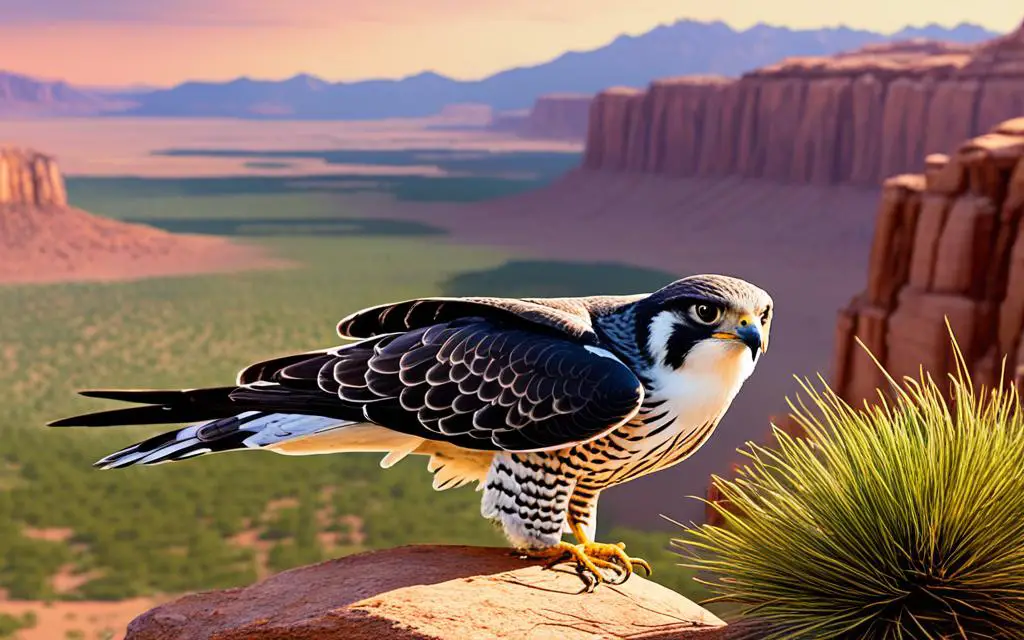
Unique Traits of Falcons
Falcons possess distinctive traits that set them apart from other birds. These traits include their long wings and exceptional eyesight, which contribute to their remarkable hunting abilities.
The long wings of falcons enable them to achieve high speeds during flight. This adaptation allows them to swiftly navigate through the air and execute quick maneuvers while pursuing prey. The streamlined shape of their wings reduces drag, facilitating rapid acceleration and agile movements in the pursuit of food.
Additionally, falcons possess exceptional eyesight, which plays a crucial role in their hunting success. Their keen vision allows them to spot prey from great distances and accurately track their movements. This remarkable visual acuity enables falcons to detect even the faintest movements of potential prey, making them highly efficient hunters in various environments.
With their unique combination of long wings for fast flight and extraordinary eyesight for precise target acquisition, falcons are truly remarkable creatures in the avian world.
Conclusion
Falcons are remarkable birds that can be found in diverse environments around the world. Their global distribution spans across continents, showcasing the adaptability of these majestic creatures.
One of the most captivating aspects of falcons is their unique characteristics. From their swift speed and agile hunting behaviors to their exceptional eyesight, falcons are well-equipped predators. Their long wings enable them to soar through the sky with grace and precision, making them a sight to behold.
For birdwatchers and nature enthusiasts, exploring the world of falcons is a thrilling adventure. The diverse falcon species offer a wide range of behaviors and habitats to discover. Whether observing the peregrine falcon’s breathtaking dive or admiring the gyrfalcon’s majestic presence, falcons truly captivate our attention and ignite our curiosity.
As we delve into the fascinating world of falcons, we gain a deeper appreciation for the wonders of nature and our interconnectedness with the animal kingdom. So let us spread our wings and embark on a journey to witness the awe-inspiring beauty and unique qualities of these incredible birds of prey.
FAQ
What are the different species of falcons?
Falcons are a diverse group of birds, with approximately 40 different species in the genus Falco.
What are some unique characteristics of falcons?
Falcons have thin, tapered wings that enable them to fly at high speeds, exhibit sexual dimorphism, and possess exceptional powers of vision.
How many species of falcons are there?
There are approximately 40 species of falcons worldwide.
Which falcon species is the largest and smallest?
The gyrfalcon is the largest falcon species, measuring up to 65 cm in length, while the pygmy falcon is the smallest, measuring just 20 cm.
What makes falcons fast and agile hunters?
Falcons have slender bodies, sharp, curved beaks, and long wings that enable them to fly at high speeds and capture their prey in flight.
Is the peregrine falcon the fastest falcon species?
Yes, the peregrine falcon is not only the fastest falcon but also the fastest animal on Earth. It can reach speeds of up to 200 mph when diving to catch its prey.
What are the habitats of falcons?
Falcons can be found in a wide range of habitats, including open country, cliffs, tundras, and even urban areas.
What caused the decline in peregrine falcon population?
The peregrine falcon population experienced a significant decline in the mid-20th century due to the use of the chemical DDT, which caused nesting failures.
How are falcons classified in taxonomy?
Falcons belong to the Falconidae family and can be further classified into Falcons, Hobbies, and Kestrels.
Where do falcons build their nests?
Falcons exhibit nesting behaviors such as using old nests of other raptors or building nests in trees or on rocky formations.
What are some unique traits of falcons?
Falcons have long wings that enable fast flight and exceptional eyesight, making them highly skilled hunters.
Source Links
- https://en.wikipedia.org/wiki/Falcon
- https://outforia.com/types-of-falcons/
- https://birdinginsider.com/types-of-falcons-guide/

My name is Shane Warren, the author behind Your Bird Buddy – your ultimate guide to the wonderful world of birds! Unleash your inner avian explorer as we delve into a vibrant library of knowledge dedicated to all things feathered. From learning about diverse bird species from across the globe to understanding their captivating habitats and behaviors, I’m here to fuel your passion for these magnificent creatures. Not only that, but I also provide valuable insights on being a responsible and informed pet bird owner. Join our vibrant community and let’s celebrate the feathered wonders of the world together – one chirp at a time. And be sure to join our Your Bird Buddy Community over on Facebook!

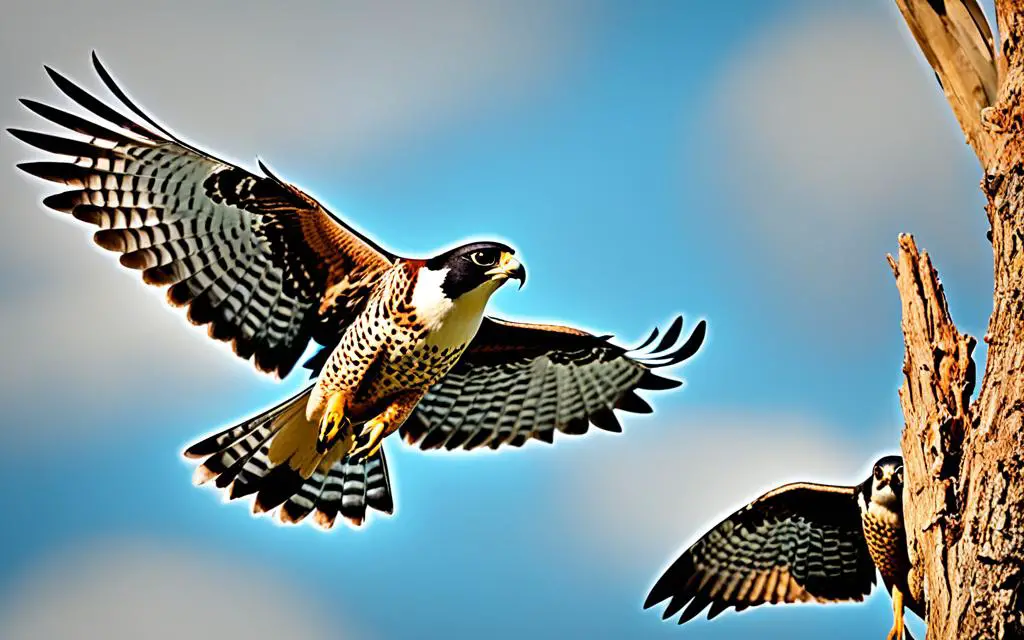
Comments are closed